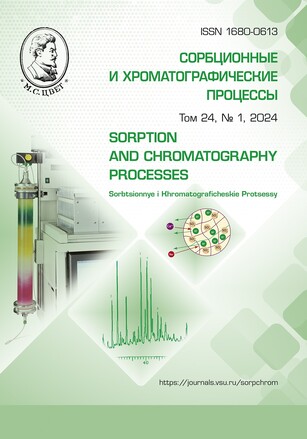Cluster adsorption of histidine enantiomers on carbon nanotubes from aqueous solutions
Abstract
The study is devoted to the analysis of adsorption isotherms of histidine enantiomers on carbon nanotubes mkNANO MKN-SWCNT S1 from aqueous solutions in the temperature range 25-80°C. Histidine enantiomers from Sigma Aldrich were used as amino acids, and mkNANO MKN-SWCNT S1 carbon nanotubes (Canada) were used as an adsorbent. Experimental data obtained by the construction of isotherms, were used to calculate the separation coefficients of enantiomers on CNTs, the values of separation coefficients were higher than for other sorbents. The interpretation of the isotherms was based on the cluster adsorption model, providing very good agreement between theory and experiment (R2=0.994-0.999), which showed that L- and D-histidine were sorbed on the surface of a nanotube in the form of monomers and clusters. Three characteristic regions were identified on the adsorption isotherms: concentration range in which only sorbate monomers were fixed on the surface of the nanotube; concentration range in which sorbate molecules were fixed on the nanotube only in the form of clusters; concentration range in which monomers and clusters were present on the surface of the sorbent. The dependence of these isotherm regions on temperature was analysed.
Downloads
References
Iijima S., Helical Microtubules of Graphitic Carbon, Nature, 1991; 354: 56-58. https://doi.org/10.1038/354056a0
De Volder M. F., Tawfick S. H., Baughman R. H., Hart A.J., Carbon Nano-tubes: Present and Future Commercial Ap-plications, Science, 2013; 339: 535-539. https://doi.org/10.1126/science.1222453.
Rao R., Pint C.L., Islam A.E., et al., Carbon Nanotubes and Related Nano-materials: Critical Advances and Challeng-es for Synthesis toward Mainstream Com-mercial Applications, ACS Nano., 2018; 12(12): 11756-11784. https://doi.org/10.1021/acsnano.8b06511
Yang F., Wang M., Zhang D., et al., Chirality Pure Carbon Nanotubes: Growth, Sorting, and Characterization, Chem. Rev., 2020; 120(5): 2693-2758. https://doi.org/10.1021/acs.chemrev.9b00835
Yu L., Shearer C., Shapter J., Recent Development of Carbon Nanotube Trans-parent Conductive Films, Chem. Rev., 2016; 116: 13413-13453. https://doi.org/10.1021/acs.chemrev.6b00179
Dai H., Hafner J.H., Rinzler A.G. Nanotubes as nanoprobes in scanning probe microscopy, Nature, 1996; 384: 147-150. https://doi.org/10.1038/384147a0
Rakov E.G., Carbon nanotubes in new materials, Russ. Chem. Rev., 2013;82(1): 27-47. https://doi.org/10.1070/RC2013v082n01ABEH004227
Postnov V.N., Rodinkov O.V., Mos-kvin L.N. From carbon nanostructures to high-performance sorbents for chromato-graphic separation and preconcentration, Russ. Chem. Rev., 2016; 85(2): 115-138. https://doi.org/10.1070/RCR4551
Zhang Z., Wang Z., Liao Y., Liu H., Applications of nanomaterials in liquid chromatography: Opportunities for separa-tion with high efficiency and selectivity, J. Sep. Sci., 2006; 29: 1872-1878. https://doi.org/10.1002/jssc.200600154
Guillaume Y.C., Andre C., Fast en-antioseparation by HPLC on a modified carbon nanotube monolithic stationary phase with a pyrenyl aminoglycoside de-rivative, Talanta, 2013; 115: 418-421. DOI: https://doi.org/10.1016/j.talanta.2013.05.073
Zhao L., Ai P., Duan A.-H., Yuan L.-M., Single-walled carbon nanotubes for improved enantioseparations on a chiral ionic liquid stationary phase in GC, Anal. Bioanal. Chem., 2011; 399: 143-147. https://doi.org/10.1007/s00216-010-4079-8
Pasteur L.C.R., Acad. Sci., 1858; 46: 615-618.
Kartsova L.A., Ob'edkova E.V., Protasova I.D., Separation of the enantio-mers of NSAIDs and ß-blockers by high performance thin layer chromatography, Sorbtsionnye i khromatograficheskie protsessy, 2013; 13(3): 257-265. (In Russ.)
Ankur, G. Nirmal M., Surajit K. En-antiomeric Recognition and Separation by Chiral Nanoparticles, Molecules, 2019; 24(6): 1-31. https://doi.org/10.3390/molecules24061007
Hemasa A.L., Naumovski N., Maher W.A., Ghanem A., Application of Carbon Nanotubes in Chiral and Achiral Separa-tions of Pharmaceuticals, Biologics and Chemicals, Nanomaterials, 2017; 7(186): 1-32. https://doi.org/10.3390/nano7070186
Chang C., Wang X., Bai Y., Liu H., Applications of nanomaterials in enanti-oseparation and related techniques, TrAC Trends Anal. Chem., 2012; 39: 195-206. https://doi.org/10.1016/j.trac.2012.07.002
Ahmed M., Yajadda M.M.A., Han Z.J., et al., Single-walled carbon nanotube-based polymer monoliths for the enantiose-lective nano-liquid chromatographic sepa-ration of racemic pharmaceuticals, J. Chromatogr. A., 2014; 1360: 100-109.
Berthod A., Chiral Recognition Mechanisms, Anal. Chem., 2006; 78(7): 2093-2099. https://doi.org/10.1021/ac0693823
Easson L.H., Stedman E., Studies on the relationship between chemical constitu-tion and physiological action. V. molecular dissymmetry and physiological activity, Biochem J., 1933; 27(4): 1257-1266. https://doi.org/10.1042/bj0271257
Dalgliesh C.E., The optical resolu-tion of aromatic amino-acids on paper chromatograms, J. Chem. Soc., 1952; 3940-3942. https://doi.org/10.1039/JR9520003940
Tinoko I., Zaujer K., Vjeng Dzh., Paglisi Dzh. Fizicheskaja Himija. Principy i primenenie v biologicheskih naukah, Per. s angl. E.R. Razumovoj pod red. V.I. Gorshhkova, M. Tehnosfera, 2005, 743p. (In Russ.)
Selemenev V.F., Rudakov O.B., Eliseeva T.V. Mezhmolekulyarnye vzai-modejstviya i obrazovanie peresyshchen-nyh rastvorov aminokislot v faze vysokoosnovnogo ani-onita. Soobshchenie 1. Vestnik Voronezhskogo gosudarstven-nogo universiteta. Se-riya: Himiya. Bi-ologiya. Farmaciya, 2021; 1: 20-35. (In Russ.)
Butyrskaya E.V., Zapryagaev S.A., Izmailova E.A., Cooperative model of the histidine and alanine adsorption on single-walled carbon nanotubes, Carbon, 2019; 143: 276-287. https://doi.org/10.1016/j.carbon.2018.10.086
Le D.T., Butyrskaya E.V., Eliseeva T.V., Cluster Adsorption of L-Histidine on Carbon Nanotubes in Aqueous Solutions at Different Temperatures, Russian Journal of Physical Chemistry A, 2022; 96(8): 1719-1723. https://doi.org/10.31857/S004445372208012X
Le D.T., Butyrskaya E.V., Eliseeva T.V., Sorption interaction between carbon nanotubes and histidine enantiomers in aqueous solutions, Russian Journal of Physical Chemistry A, 2021; 95(11): 2280-2286. https://doi.org/10.1134/S003602442111011X
Le D.T., Butyrskaya E.V., Volkov A.A., Gneushev A.S., Study of adsorption of histidine enantiomers on carbon nano-tubes in aqueous solution based on differ-ent adsorption models, Sorbtsionnye i khromatograficheskie protsessy, 2022; 22(3): 235-242. https://doi.org/10.17308/sorpchrom.2022.22/9330 (In Russ.)
Scriba G.K.E., Chiral Recognition Mechanisms in Analytical Separation Sci-ences, Chromatographia, 2012; 75: 815-838. https://doi.org/10.1007/s10337-012-2261-1 (In Russ.)
Anan'eva I.A., Shapovalova E.N., Shpigun O.A., Armstrong D.V., Razdelenie opticheski aktivnykh aminokislot i izomerov ikh proizvodnykh na makrotsi-klicheskom antibiotike «tikoplanin», Vestn. Mosk. Un-Ta., Ser. 2., Khimiya, 2001; 42(4,): 278-280. (In Russ.)
Şarkaya, K. Süleyman A., Ilgım G., Separation of histidine enantiomers by ca-pillary electrochromatography with molec-ularly imprinted monolithic columns, Sep-aration Science Plus., 2000; 1-11. https://doi.org/10.1002/sscp.201900101
Morvan M., Mikšík I., Recent Ad-vances in Chiral Analysis of Proteins and Peptides, Separations, 2021; 8(112): 1-28.
Sarvin N., Puzankov R., Vasiyarov G., et al. Silica immobilised chloro- and amido- derivatives of eremomycine as chi-ral stationary phases for amino acids enan-tiomers separation by reversedphase liquid chromatography, Molecules, 2023; 28 (1): 85. https://doi.org/10.3390/molecules28010085
Le D.T., Butyrskaya E.V., Volkov A.A., Gneushev A.S., Study of adsorption of histidine enantiomers on carbon nano-tubes in aqueous solution based on differ-ent adsorption models, Sorbtsionnye i khromatograficheskie protsessy, 2022; 22(3): 235-242. https://doi.org/10.17308/sorpchrom.2022.22/9330. (In Russ.)
Butyrskaya E.V., Single-layer clus-ter adsorption model and its application for the estimation of the CO2 structure on met-al-organic frameworks, Materials Today Communications, 2022; 33: 104327. https://doi.org/10.1016/j.mtcomm.2022.10432







